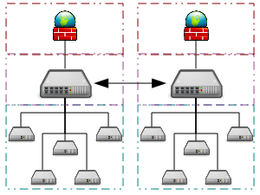Inter-process communication: Difference between revisions
Fixed typo Tags: Reverted Visual edit Mobile edit Mobile web edit |
Fixed typo Tags: Reverted Visual edit Mobile edit Mobile web edit |
||
| Line 30: | Line 30: | ||
=== Platform communication stack === |
=== Platform communication stack === |
||
The following are messaging, and information systems that utilize IPC mechanisms but don't implement IPC themselves: |
The following are messaging, and information systems that utilize IPC mechanisms but don't implement IPC themselves: |
||
{{Div col|colwidth=30em}} |
|||
* [[KDE]]'s [[Desktop communication protocol|Desktop Communications Protocol]] (DCOP){{snd}} deprecated by D-Bus |
|||
* [[D-Bus]] |
|||
* [[OpenWrt]] uses [https://openwrt.org/docs/techref/ubus ubus] micro bus architecture |
|||
* [[MCAPI]] Multicore Communications API |
|||
* [[SIMPL]] The Synchronous Interprocess Messaging Project for [[Linux]] (SIMPL) |
|||
* [[9P (protocol)|9P]] (Plan 9 Filesystem Protocol) |
|||
* [[Distributed Computing Environment]] (DCE) |
|||
* [[Thrift (protocol)|Thrift]] |
|||
* [[ZeroC]]'s [[Internet Communications Engine]] (ICE) |
|||
* [[ØMQ]] |
|||
* [[Enduro/X]] Middleware |
|||
* [http://www.inspirel.com/yami4 YAMI4] |
|||
* [[Enlightenment_(software)]] E16 uses eesh as an IPC |
|||
{{div col end}} |
|||
=== Operating system communication stack === |
=== Operating system communication stack === |
||
Revision as of 17:36, 19 July 2022
This article includes a list of general references, but it lacks sufficient corresponding inline citations. (August 2015) |

In computer science, inter-process communication or interprocess communication (IPC) refers specifically to the mechanisms an operating system provides to allow the processes to manage shared data. Typically, applications can use IPC, categorized as clients and servers, where the client requests data and the server responds to client requests. Many applications are both clients and servers, as commonly seen in distributed computing.
IPC is very important to the design process for microkernels and nanokernels, which reduce the number of functionalities provided by the kernel. Those functionalities are then obtained by communicating with servers via IPC, leading to a large increase in communication when compared to a regular monolithic kernel. IPC interfaces generally encompass variable analytic framework structures. These processes ensure compatibility between the multi-vector protocols upon which IPC models rely.
An IPC mechanism is either synchronous or asynchronous. Synchronization primitives may be used to have synchronous behavior with an asynchronous IPC mechanism.
Approaches
Different approaches to IPC have been tailored to different software requirements, such as performance, modularity, and system circumstances such as network bandwidth and latency.
Applications
Remote procedure call interfaces
- Java's Remote Method Invocation (RMI)
- ONC RPC
- XML-RPC or SOAP
- JSON-RPC
- Message Bus (Mbus) (specified in RFC 3259) (not to be confused with M-Bus)
- .NET Remoting
- gRPC
Platform communication stack
The following are messaging, and information systems that utilize IPC mechanisms but don't implement IPC themselves:
Operating system communication stack
The following are platform or programming language-specific APIs:
- Apple Computer's Apple events, previously known as Interapplication Communications (IAC)
- ARexx ports
- Enea's LINX for Linux (open source) and various DSP and general-purpose processors under OSE
- The Mach kernel's Mach Ports
- Microsoft's ActiveX, Component Object Model (COM), Microsoft Transaction Server (COM+), Distributed Component Object Model (DCOM), Dynamic Data Exchange (DDE), Object Linking and Embedding (OLE), anonymous pipes, named pipes, Local Procedure Call, MailSlots, Message loop, MSRPC, .NET Remoting, and Windows Communication Foundation (WCF)
- Novell's SPX
- POSIX mmap, message queues, semaphores,[1] and shared memory
- RISC OS's messages
- Solaris Doors
- System V's message queues, semaphores, and shared memory
- Linux Transparent Inter Process Communication (TIPC)
- OpenBinder Open binder
- QNX's PPS (Persistent Publish/Subscribe) service
Distributed object models
The following are platform or programming language specific-APIs that use IPC, but do not themselves implement it:
- Libt2n for C++ under Linux only, handles complex objects and exceptions
- PHP's sessions
- Distributed Ruby
- Common Object Request Broker Architecture (CORBA)
- Electron's asynchronous IPC, shares JSON objects between a main and a renderer process[2]
See also
- Computer network programming
- Communicating Sequential Processes (CSP paradigm)
- Data Distribution Service
- Protected procedure call
References
- Stevens, Richard. UNIX Network Programming, Volume 2, Second Edition: Interprocess Communications. Prentice Hall, 1999. ISBN 0-13-081081-9
- U. Ramachandran, M. Solomon, M. Vernon Hardware support for interprocess communication Proceedings of the 14th annual international symposium on Computer architecture. Pittsburgh, Pennsylvania, United States. Pages: 178 - 188. Year of Publication: 1987 ISBN 0-8186-0776-9
- Crovella, M. Bianchini, R. LeBlanc, T. Markatos, E. Wisniewski, R. Using communication-to-computation ratio in parallel program designand performance prediction 1–4 December 1992. pp. 238–245 ISBN 0-8186-3200-3
External links
- Linux ipc(5) man page describing System V IPC
- Windows IPC
- IPC available using Qt
- Unix Network Programming (Vol 2: Interprocess Communications) by W. Richard Stevens
- Interprocess Communication and Pipes in C
- DIPC, Distributed System V IPC
